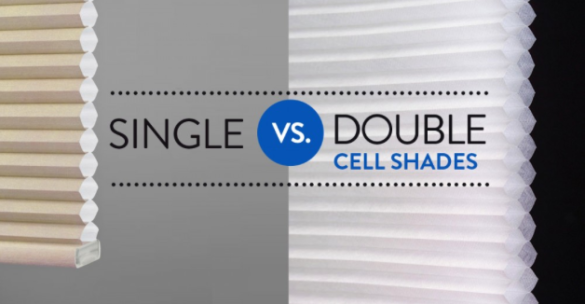What is the difference between Single-Cell vs. Double-Cell Cellular Shades

So, let’s focus on one thing today: window shades. You know you are leaning toward a cellular or honeycomb blind, but are confused whether a single or double cell shade will benefit your home. We will shed light on the pros and cons of each so you can make an informed decision.
What Is a Cellular Shade?
Simply put, cellular shades or blinds are constructed with cell pockets that resembled a honeycomb when viewed from the side. The cellular shape promotes insulation and thus energy efficiency, but they are not a one-size-fits-all option. Aside from just differing aesthetically, there are two different types of cellular shades: single-cellular and double-cellular shades.
Single-cell shades are made by with each honeycomb component stacked on top of the other, creating a single cell in each row. The double cellular shades are made of two intertwined cells, hence the name “double cell.”
Insulation and Light
The first thing we will look at is insulation. Cellular shades are known for their good insulation; while each of them provides insulation, however, double cell shades have a much greater ability to keep the outside temperatures out and the inside temperatures in. Another issue related to insulation is solar heat gain, which refers to sunlight shining through unobstructed windows, raising the temperature inside the home. For rooms that receive lots of sunlight, double-cell shades are more effective.
Next, let’s talk about ultraviolet blockage. We don’t want harmful UV rays shining right into our homes. With cellular shades, each type is effective in blocking these rays. Both single-cell and double-cell have been shown to effectively block those harmful UV rays from making their way into your home.
Aesthetics
Are you more concerned with the shades being aesthetically pleasing and complementary to the look of the room? If so, then a single-cell blind might be a better option. Double-cell blinds tend to only come in one size, which is a smaller cell size. Single-cell shades come in many different sizes, including large format sizes that can add a more modern look to a home.
The Cost
Now that we’ve looked at the functionality of the two types of blinds, let’s talk about everyone’s favorite subject—the cost. Double-cell shades tend to come with a higher price point, because their construction is more intricate than single-cell shades. The extra material and detail will leave you paying a little more money.
Now that you have the pros and cons, it is time to narrow down what is most important to you. Is it paying a little less money and sticking with a single-cell cellular shade? Or is insulation a much more important factor for you? Once you have your preferences narrowed down, you will assuredly love whichever cellular shade you choose.
Reprinted from Window Coverings Association of America.

